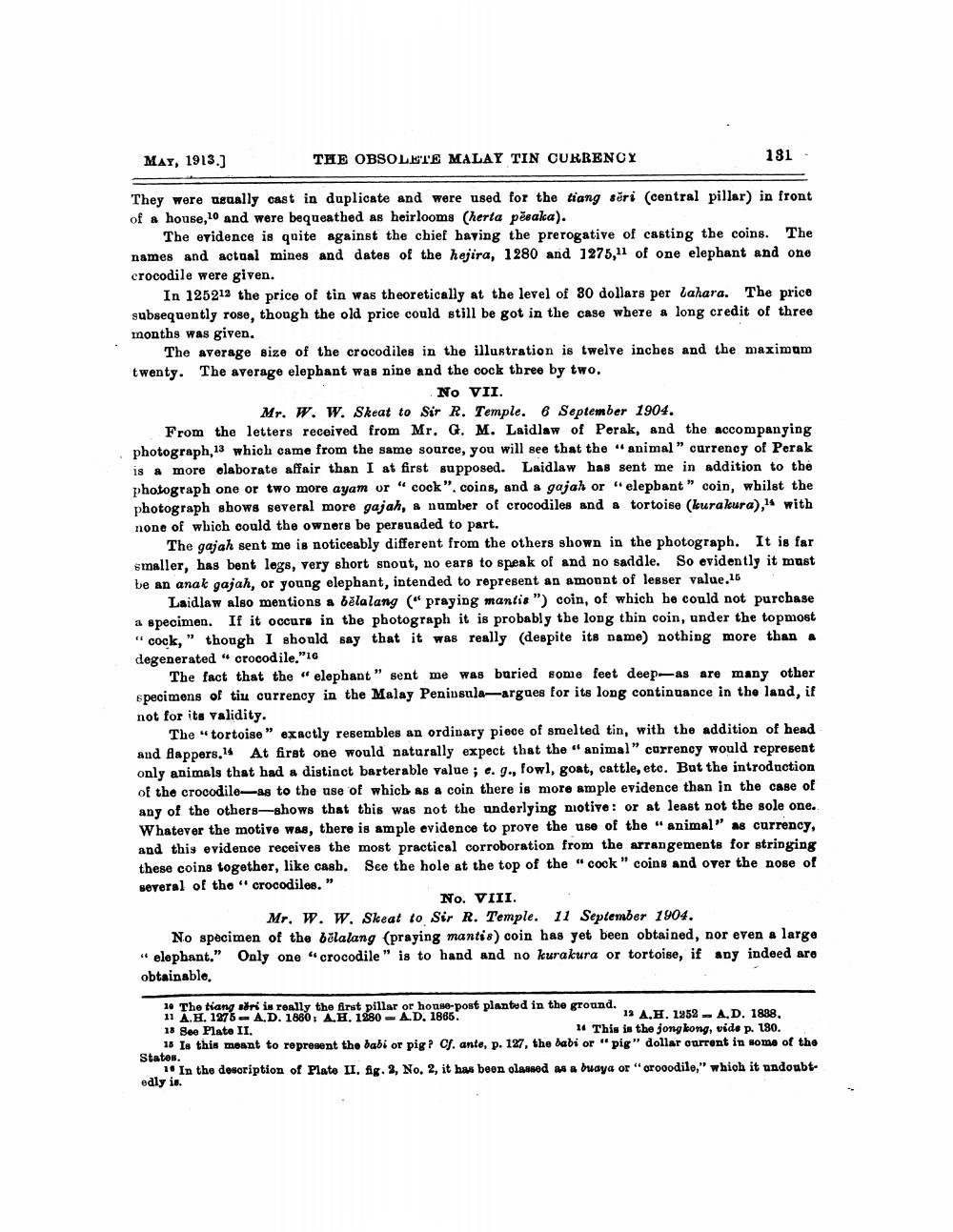________________
MAY, 1913.)
THE OBSOLETE MALAY TIN CURRENCY
181
They were usually cast in duplicate and were used for the tiang sēri (central pillar) in front of a house, 10 and were bequeathed as heirlooms (herta pěsaka).
The evidence is quite against the chief having the prerogative of casting the coins. The names and actual mines and dates of the hejira, 1280 and 1275,11 of one elephant and one crocodile were given.
In 125212 the price of tin was theoretically at the level of 80 dollars per lahara. The price subsequently rose, though the old price could still be got in the case where a long credit of three months was given.
The average size of the crocodiles in the illustration is twelve inches and the maximam twenty. The average elephant was nine and the cock three by two.
NO VII. Mr. W. W. Skeat to Sir R. Temple. 6 September 1904. From the letters received from Mr. G. M. Laidlaw of Perak, and the accompanying photograph,13 which came from the same source, you will see that the "animal" currency of Perak is a more elaborate affair than I at first supposed. Laidlaw has sent me in addition to the photograph one or two more ayam or " cock". coins, and a gajah or "elepbant" coin, whilst the photograph shows several more gajah, a number of crocodiles and a tortoise (kurakura), with none of which could the owners be persuaded to part.
The gajah sent me is noticeably different from the others shown in the photograph. It is far smaller, has bent legs, very short snout, no ears to speak of and no saddle. So evidently it must be an anak gajah, or young elephant, intended to represent an amonnt of lesser value.15
Laidlaw also mentions a bělalang ( praying mantis") coin, of which he could not purchase a specimen. If it occurs in the photograph it is probably the long thin coin, under the topmost “cock,” though I should say that it was really (despite its name) nothing more than a degenerated “ crocodile,"16
The fact that the “ elephant" sent me was buried some feet deep-as are many other specimens of tiu currency in the Malay Peninsula-argues for its long continuance in the land, if not for its validity.
The tortoise" exactly resembles an ordinary piece of smelted tin, with the addition of head and flappers,14 At first one would naturally expect that the "animal" currency would represent only animals that had a distinct barterable value ; e. g., fowl, goat, cattle, ete. But the introduction of the crocodile-as to the use of whicb as a coin there is more emple evidence than in the case of any of the others-shows that this was not the underlying motivo: or at least not the sole one. Whatever the motive was, there is ample evidence to prove the use of the "animal" as currency, and this evidence receives the most practical corroboration from the arrangements for stringing these coins together, like cash. See the hole at the top of the "cock" coins and over the nose of several of the “crocodiles."
No. VIII. Mr. W. W. Skeat to Sir R. Temple. 11 September 1904. No specimen of the bělalang (praying mantis) coin has yet been obtained, nor even a large " elephant.” Only one "crocodile" is to hand and no kurakura or tortoise, if any indeed are obtainable,
2. The tiang sdri is really the first pillar or house-post planted in the ground... 11 A.H. 1275 - A.D. 1880. A.H. 1280 - AD. 1865.
1 A.H. 1252 - A.D. 1888. 18 See Plate II.
14 This is the jongkong, vide p. 180. 15 Is this meant to represent the babi or pig? Cf. ante, p. 127, the babi or "pig" dollar ourrent in some of the States.
1. In the description of Plato II. fig. 2, No. 2, it has been planned as a buaya or " orooodile," which it undoubtedly is.




